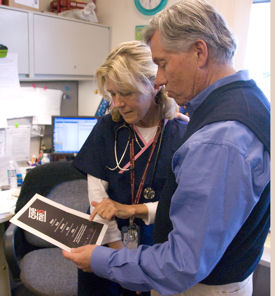In-office lab tests augment patient self-education efforts
Fifth in a six-part series on small practice issues.
Patient education at the office of general internist Christopher Mays, ACP Member, had long been limited to pamphlets in the exam rooms and a notebook of advance directives at the front desk. Then the ACP's Center for Practice Innovation (CPI) came for a visit as part of its two-year initiative to improve small practices.

“Before, education happened when a patient had a certain problem, and the doctor or physician's assistant pulled out a sheet based on that problem,” said Dawn Cooke, practice manager for the Olney, Md. office. “When the CPI pointed out we didn't have general information for patients in the waiting room, I went on a mission.”
She started at the ACP Web site, printing out pages that explained internal medicine and its specialties, and putting these in a binder with page protectors. To her surprise, the patients were not only interested, they asked for copies. So she decided to ask them for more ideas on the kinds of material to offer.
“They said they wanted to know about different radiology procedures, and the locations of labs around town,” Ms. Cooke said. “It was eye-opening for us, because we used to worry about a cluttered waiting room. Now we have way more information.”
Creating a stimulating waiting room environment is just one way of engaging patients in their own health, according to several practices involved with the CPI project. Patient education and in-office lab testing often serve the same end—albeit in very different ways.
Opportunities to educate
Husband-and-wife team Christine Sinsky, ACP Member and Tom Sinsky, MD, use the annual physical examination as a time for patient education at their general internal medicine practice in Dubuque, Iowa.
The approach is preferable to cramming “teaching moments” into every possible visit, because it not only ensures the education gets done, it serves as a way to stay organized, Dr. Tom Sinsky said.
“We use this time to coach about healthy lifestyles, and do screenings and management of chronic conditions. It is a complex, rich visit where we focus on integrative care,” Dr. Tom Sinsky said. “When a patient comes in at other times with a specific complaint, it allows us to focus on that complaint, because we know those other things will be taken care of.”
Another husband-wife internist team in Oswego, Ill., Angela Egly, ACP Member, and Kevin Egly, ACP Member, makes it a priority to provide patients with as much information from their visit as they desire. This includes patient education handouts, health summaries of their medical history generated by an electronic health record, information about local specialists, and copies of labs, chart notes and studies.
The couple also encourages their patients to take part in a 10-minute Web-based survey, which identifies patient-specific concerns.
“(The tool) allows us to assess our patients' confidence in self-care,” Dr. Angela Egly said. “And the data gathered from it helps us assess all the other components of our patient-centered collaborative care, so we can make practice improvements.”
Paula Woodward, RN, senior clinical associate for the CPI, applauded these efforts, and said she'd like to see practices test their patients' health literacy, as well. To that end, an online screening tool called “Newest Vital Sign” can be used in three minutes to identify patients at risk for low health literacy in English and Spanish, she noted.
“The more I learn about the topic of health literacy and how strongly it is connected to patient self-management, the more I'd like to see physicians screen for literacy,” Ms. Woodward said.
Many ways to approach labs
Some practices avoid the hassle of ordering and tracking labs by having point-of-care testing in their offices. The benefit is not only that it is convenient for the physicians; it also helps get patients involved in their care, said Dr. Angela Egly.
“In our office, we do A1c, lipid panel, glucose, ALT (alanine aminotransferase), AST (aspartate aminotransferase) and INR (international normalized ratio),” Dr. Egly said. “This allows us to address care at the time of the visit and answer questions, so we don't have to do follow-up calls later. It also allows us to do adjustments for medication and devise a treatment plan with the patient.”
Keith Michl, FACP, of Manchester Center, Vt., started with a few CLIA (Clinical Laboratory Improvement Act)-waived tests at his solo practice, and then eventually moved to a CLIA moderately complex lab, for similar reasons.
“I don't think it's a huge profit center, but I do think patients are impressed that if they are sick and here for a same-day appointment, we can turn their labs around quickly,” Dr. Michl said. “And it improves workflow in the sense that I don't have to call the next day and tell them to adjust their Coumadin. Plus I can bill for it because the patient is in the office, and I couldn't if I had to call.”
Zahid Nazir, ACP member, has a moderately complex lab at the internal medicine practice he shares with his father-in-law, Mohammed Ismail, MD, in Latham, N.Y. Dr. Nazir's sister-in-law, Ghazala Nathu, MD, PhD, runs the lab, which handles everything from hematology testing to liproprofiles to virology and bacteriology.
“If a patient has new onset of fatigue or shortness of breath, I can order a test right away to see if that patient is anemic, and then manage appropriately right way,” Dr. Nazir said.
Having such a sophisticated lab doesn't make the practice any money; it's all about improving quality for the patients, he added. Ms. Nathu, who is certified as a lab director by New York State, even comes into the office early on Saturday mornings to do tests that involve fasting, so that elderly patients don't have to travel to the hospital far away.
“It's costly to run such a complex lab,” said Ms. Woodward. “Smaller practices have a harder time running one profitably than do larger practices. Dr. Ismail and Dr. Nazir provide quite a bit of charity care in their lab.”
The Sinskys, whose multi-specialty group also has a highly sophisticated lab, have an innovative approach to testing. Depending on the type of lab needed, their patients either come in an hour before their appointment to have tests done, or have the test done a few days in advance of their scheduled visit with the internists.
“This way, when I see the patient, I can look at the lab values in context,” Dr. Christine Sinsky said. “I don't get in a situation where, three days later, I have to reconstruct the details of the patient encounter to make an informed decision about the lab results.”
About 85%-90% of their patients have labs done in advance, the Sinskys said. And while there are rare situations where a patient who had a lab three days before shows up and needs another one, he or she never minds, Dr. Christine Sinsky said.
“They accept it, and they are adherent about getting their labs done ahead of time,” she said. “I think it's a reflection of how much value they find in being able to have their results explained to them face-to-face, as opposed to getting a letter.”
The Sinsky system is simple: the physician gives the patient a piece of paper on which is written the approximate date of the next appointment, and which indicates the labs the patient will need a few days before that appointment. The patient takes the paper to the receptionist, who enters the information into a computer. This triggers a reminder phone call and letter to the patient a few days before the lab is scheduled.
The sheet itself contains a list of lab and X-ray studies that are commonly used to evaluate patients, along with a default diagnosis for each test. When a physician wants to order a lab, he or she simply checks off the appropriate lab and diagnosis, and sends the patient off to the scheduler.
“We also have a number of standard order sets, like for diabetic care, hypertension and annual preventive exams, on the sheet. So again, with a single check, I can order a panel of lab studies, and the diagnosis is all set,” said Dr. Tom Sinsky. “This helps me avoid errors of omission—I won't forget the microalbumin along with the A1c for a diabetic.”




